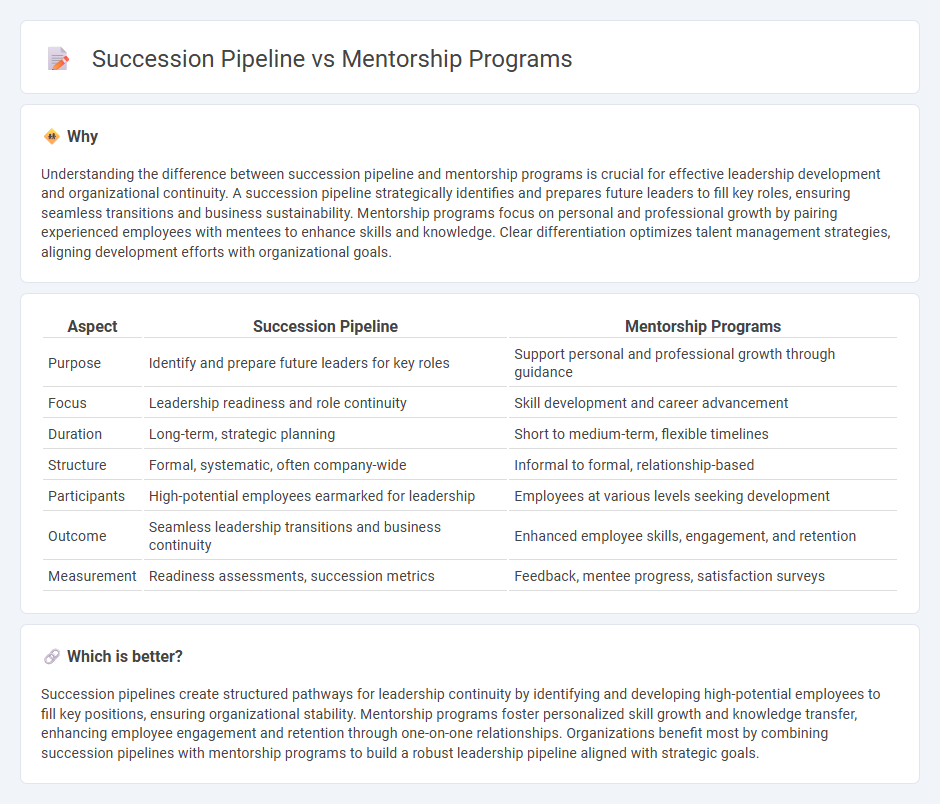
Succession pipelines strategically identify and develop high-potential leaders to ensure organizational continuity, while mentorship programs focus on personal growth through one-on-one guidance and skill-building. Both approaches enhance talent management but serve distinct purposes in leadership development frameworks. Explore the differences and benefits of each to optimize your management strategy.
Why it is important
Understanding the difference between succession pipeline and mentorship programs is crucial for effective leadership development and organizational continuity. A succession pipeline strategically identifies and prepares future leaders to fill key roles, ensuring seamless transitions and business sustainability. Mentorship programs focus on personal and professional growth by pairing experienced employees with mentees to enhance skills and knowledge. Clear differentiation optimizes talent management strategies, aligning development efforts with organizational goals.
Comparison Table
| Aspect | Succession Pipeline | Mentorship Programs |
|---|---|---|
| Purpose | Identify and prepare future leaders for key roles | Support personal and professional growth through guidance |
| Focus | Leadership readiness and role continuity | Skill development and career advancement |
| Duration | Long-term, strategic planning | Short to medium-term, flexible timelines |
| Structure | Formal, systematic, often company-wide | Informal to formal, relationship-based |
| Participants | High-potential employees earmarked for leadership | Employees at various levels seeking development |
| Outcome | Seamless leadership transitions and business continuity | Enhanced employee skills, engagement, and retention |
| Measurement | Readiness assessments, succession metrics | Feedback, mentee progress, satisfaction surveys |
Which is better?
Succession pipelines create structured pathways for leadership continuity by identifying and developing high-potential employees to fill key positions, ensuring organizational stability. Mentorship programs foster personalized skill growth and knowledge transfer, enhancing employee engagement and retention through one-on-one relationships. Organizations benefit most by combining succession pipelines with mentorship programs to build a robust leadership pipeline aligned with strategic goals.
Connection
Succession pipeline development relies on mentorship programs to identify and groom high-potential employees for future leadership roles, ensuring continuity in organizational management. Mentorship programs facilitate knowledge transfer, skill development, and cultural alignment critical for preparing successors to assume key positions effectively. Integrating mentorship into succession planning enhances talent retention and accelerates leadership readiness within the management framework.
Key Terms
Mentorship Programs:
Mentorship programs foster personalized guidance and skill development by pairing experienced leaders with emerging talent, enhancing employee engagement and knowledge transfer within organizations. These programs create a culture of continuous learning and professional growth, contributing to improved retention rates and leadership readiness. Discover how mentorship programs can transform your talent development strategy and drive long-term business success.
Guidance
Mentorship programs focus on personalized guidance, fostering individual growth through expert advice and support, which enhances skills and professional development. Succession pipelines prioritize strategically preparing internal candidates for future leadership roles by systematically developing their competencies to ensure organizational stability. Explore how tailored mentorship can complement succession planning to maximize talent readiness.
Skill Development
Mentorship programs emphasize personalized skill development by pairing experienced professionals with mentees to enhance specific competencies and address individual learning needs. Succession pipelines focus on systematically preparing high-potential employees for future leadership roles through structured training and performance milestones. Explore various strategies to effectively integrate mentorship and succession planning for robust skill development.
Source and External Links
Mentorship Programs in the Workplace: Your 2025 Ultimate Guide - Describes six types of mentorship programs including traditional, reverse, and group mentorship, emphasizing knowledge transfer, career growth, and fostering diverse learning relationships.
The Ultimate Guide to Structuring An Effective Mentorship Program - Offers a six-step framework for building mentorship programs aligned with organizational goals, including setting objectives, choosing formats like one-on-one or group mentoring, and measuring success.
Mentoring Programs: Purpose, Benefits + How to Get Your ... - Explains nine mentoring models, such as one-on-one, peer, group, and reverse mentoring, highlighting their different purposes and mutual benefits for mentors and mentees.
 dowidth.com
dowidth.com